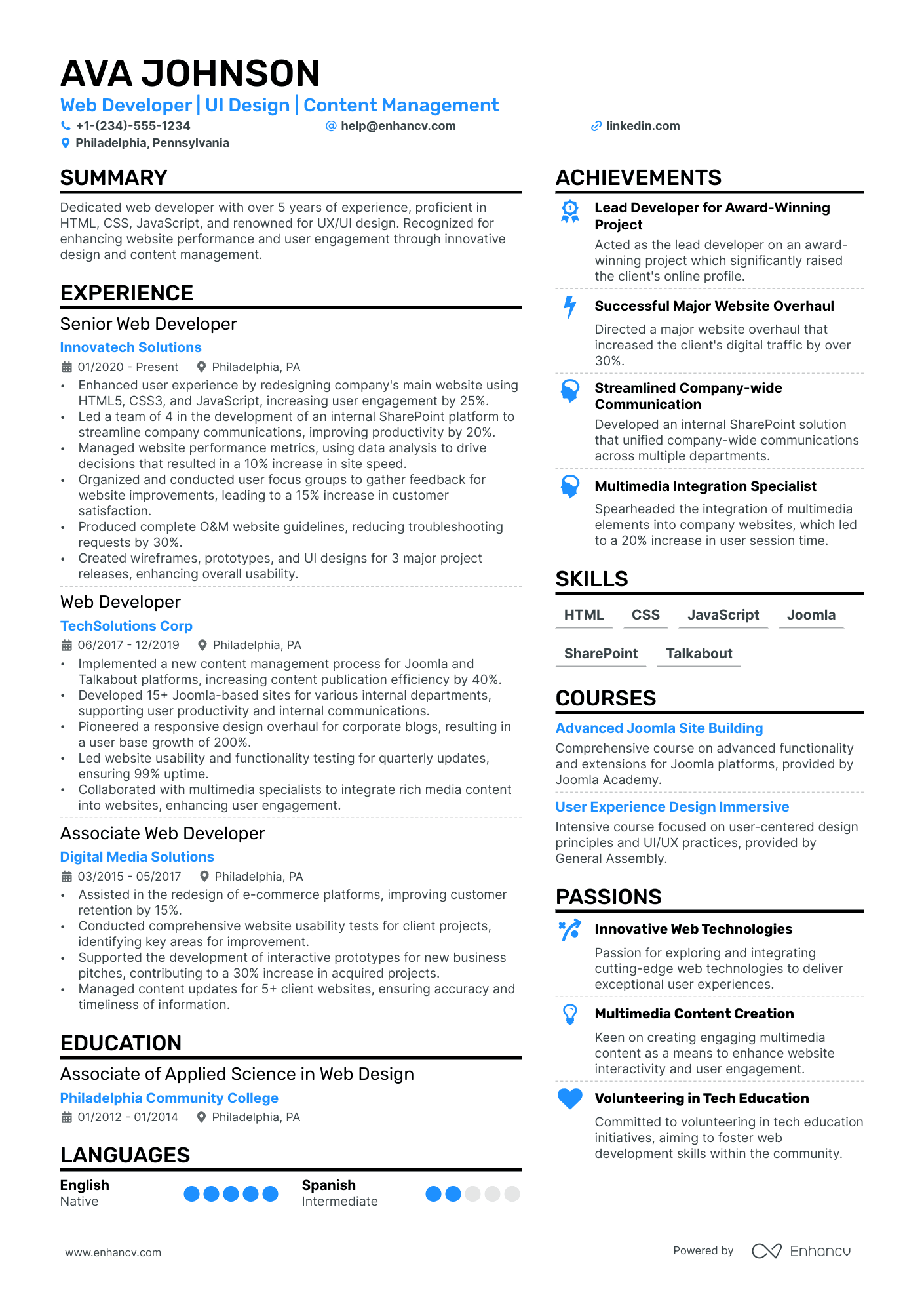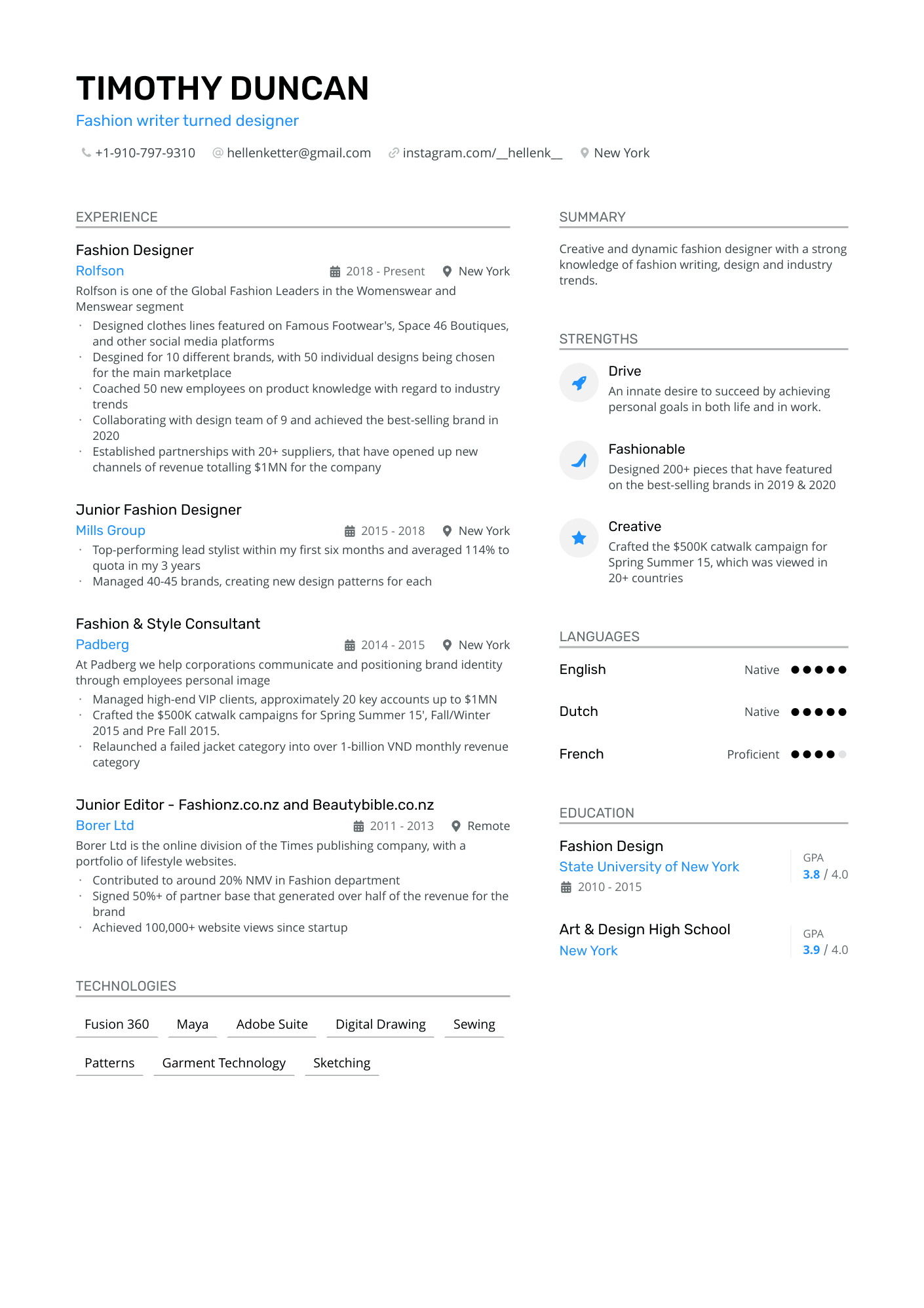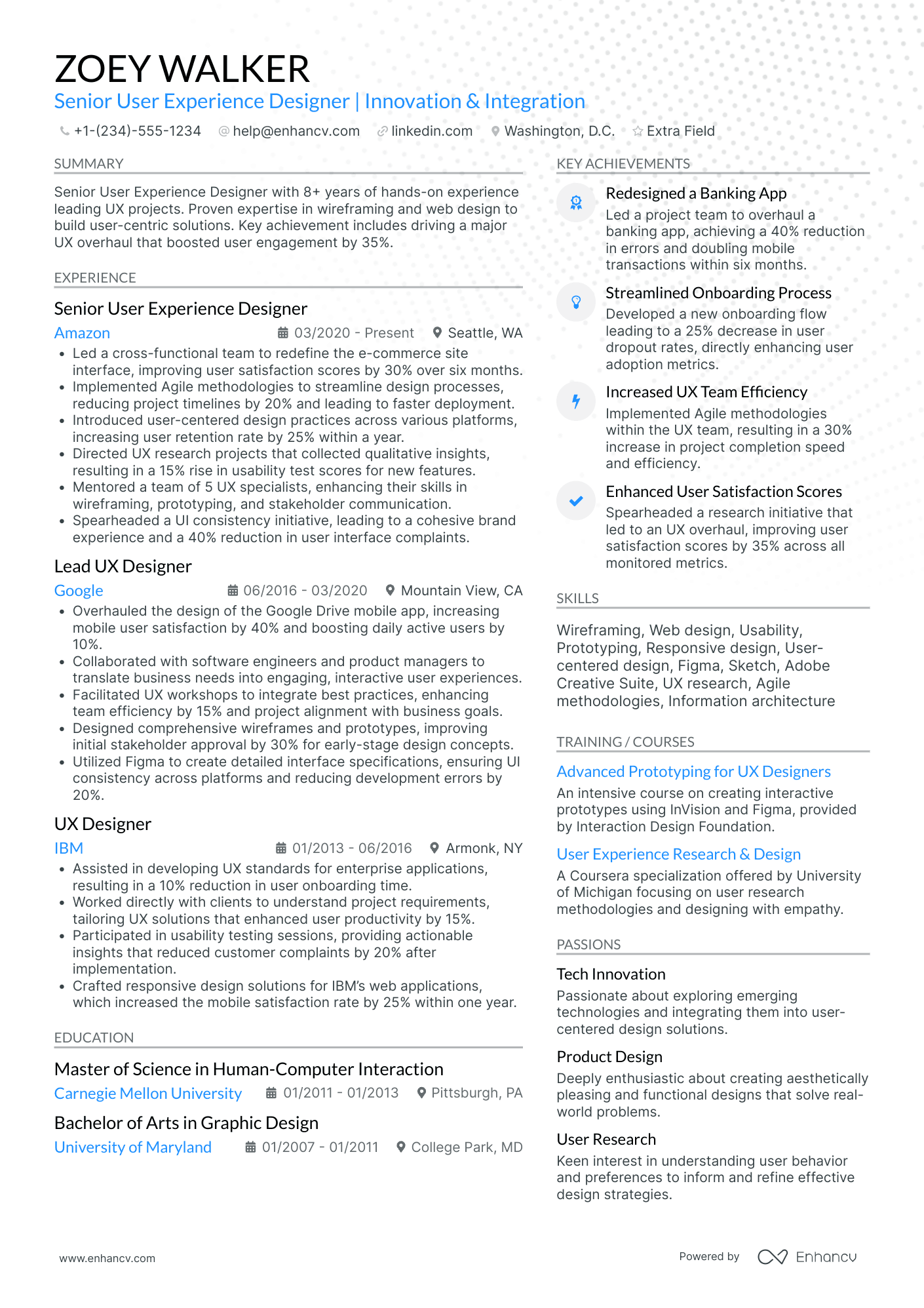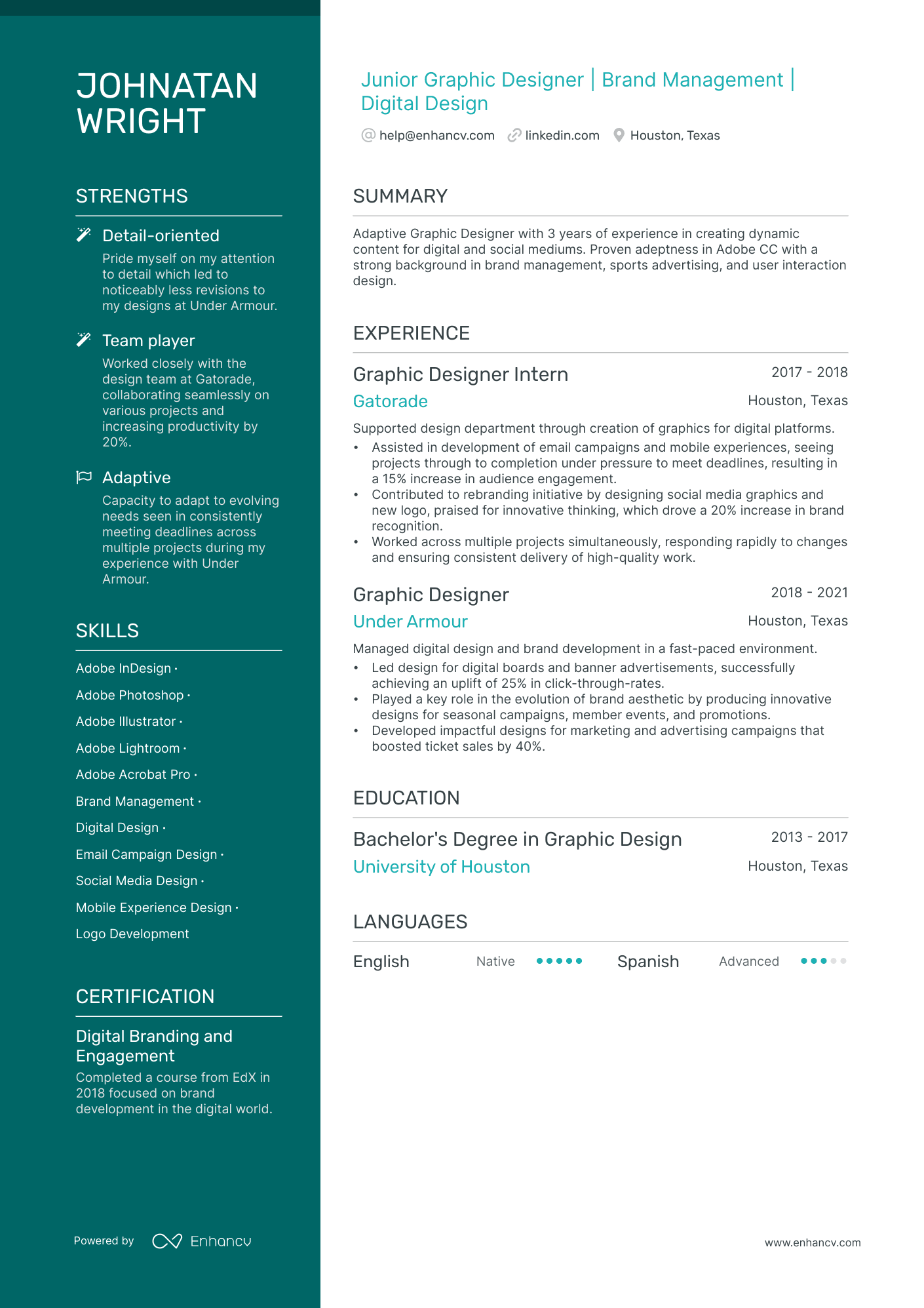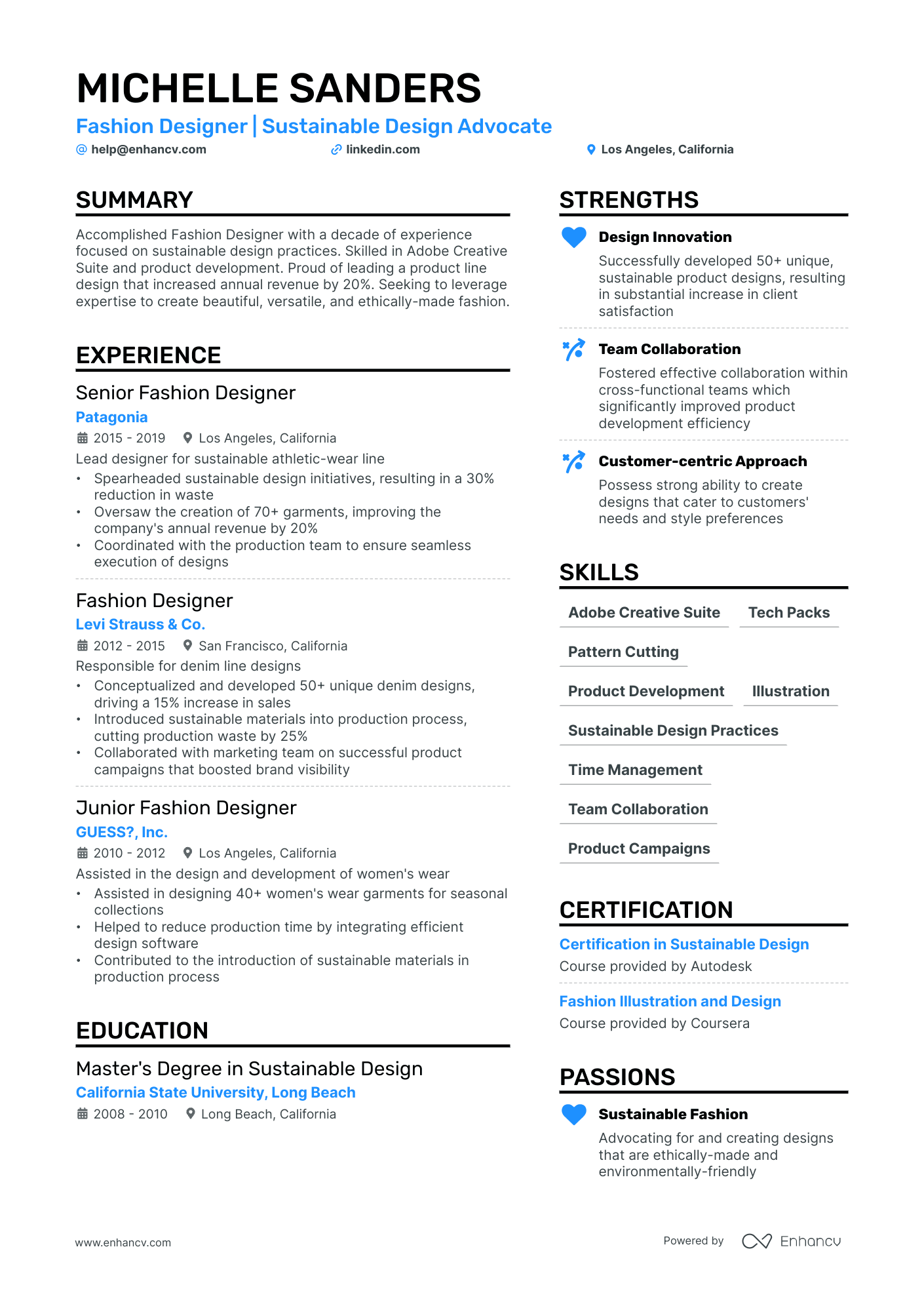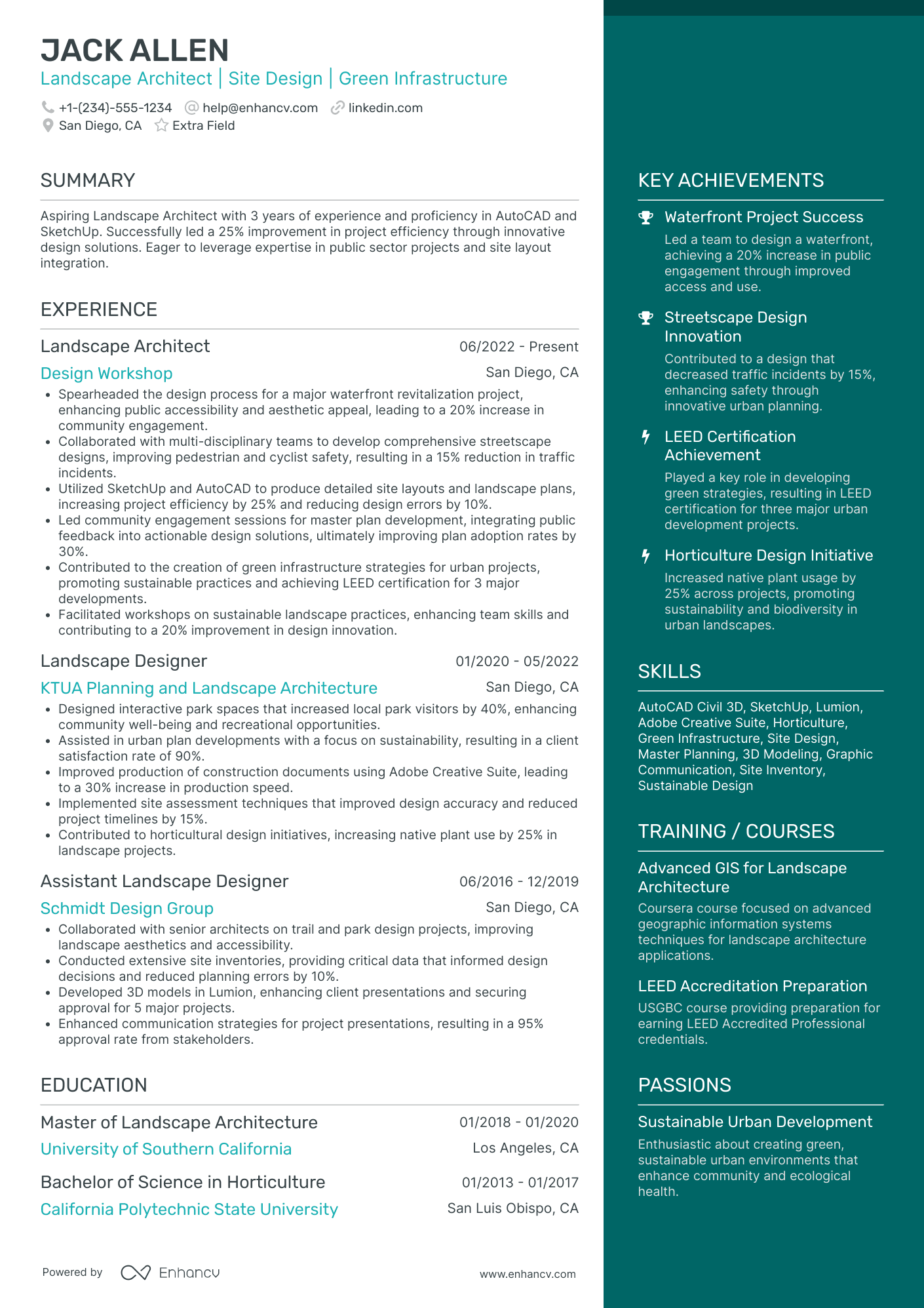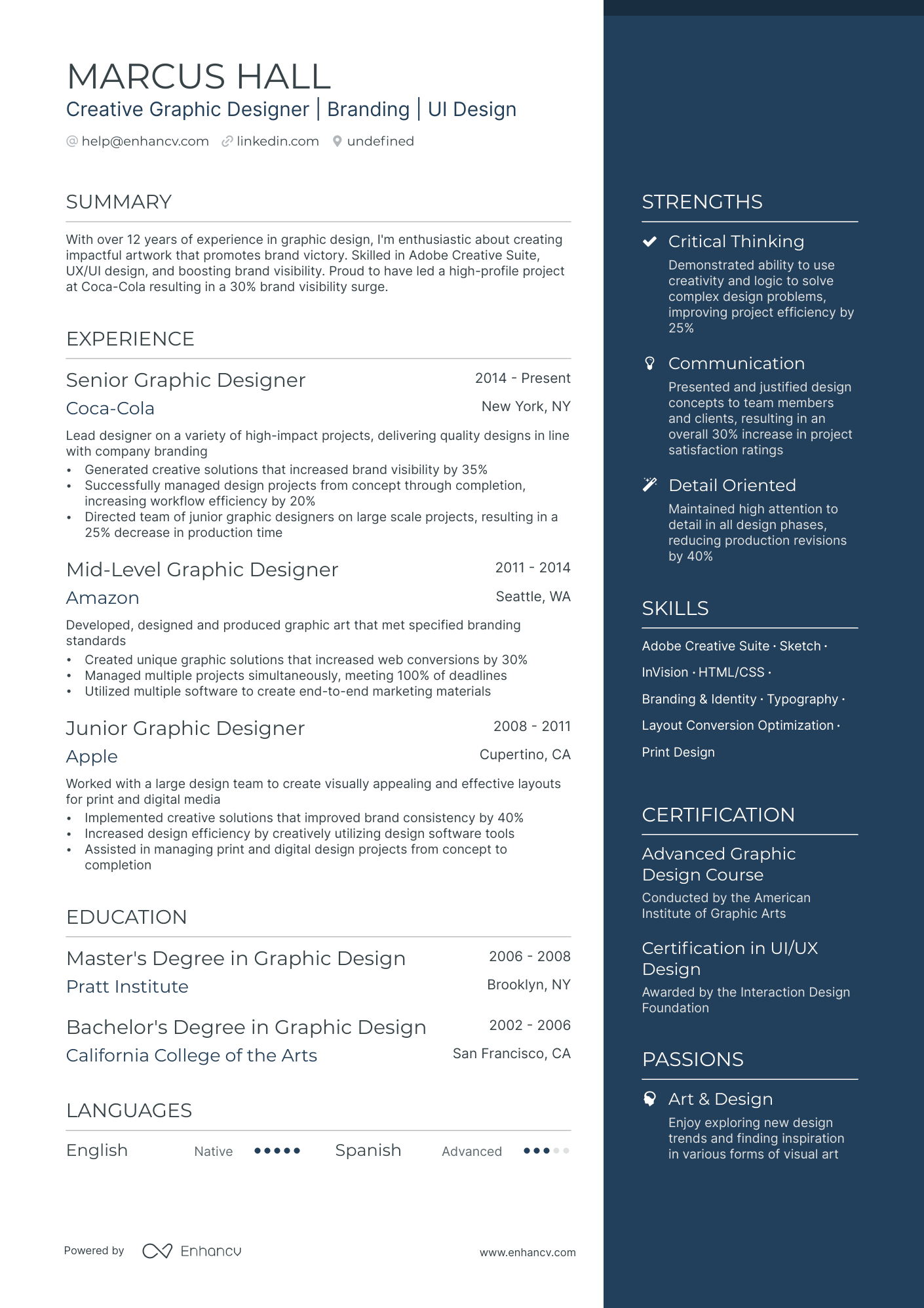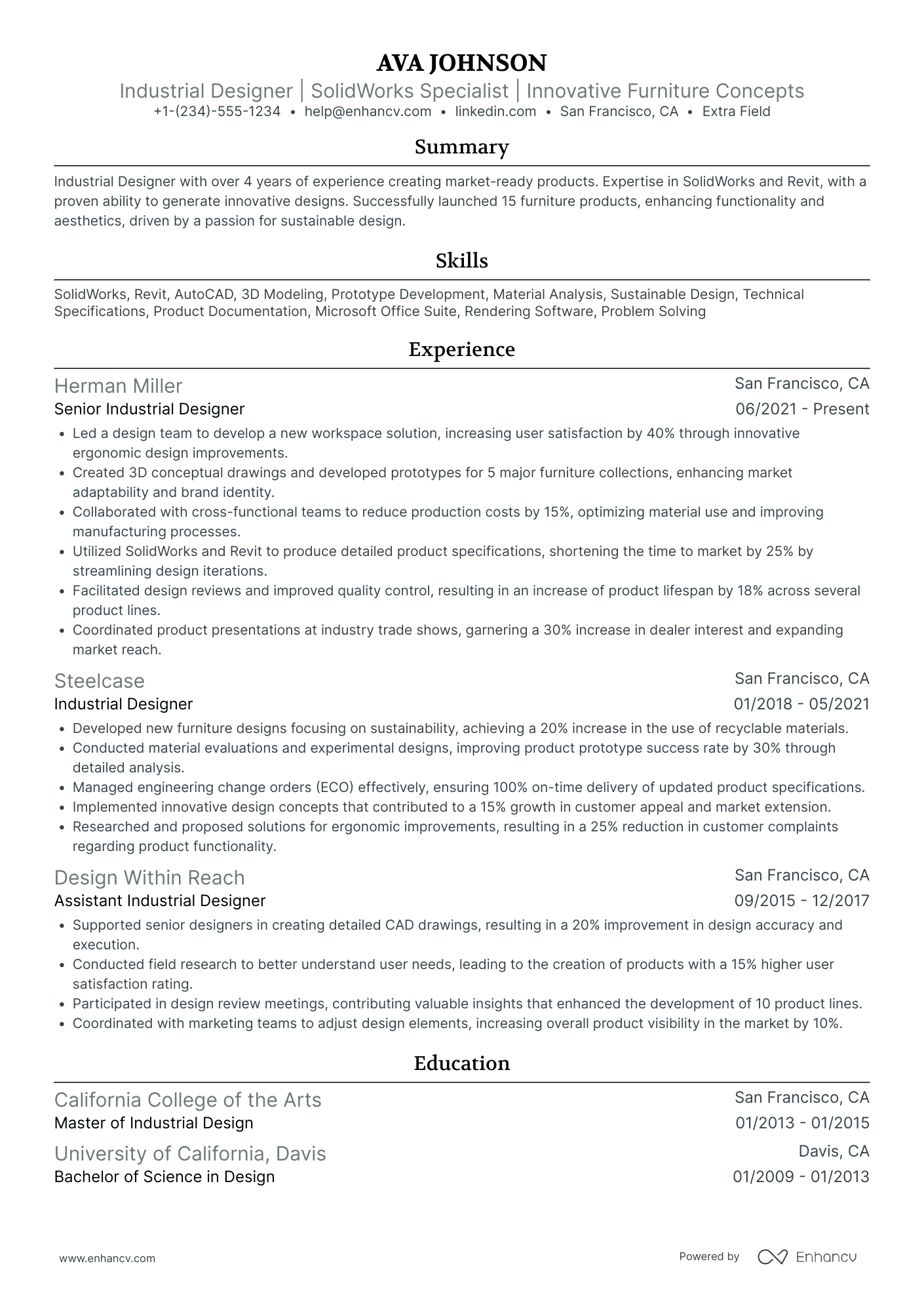The job outlook for designers is always improving. It doesn’t matter if businesses realize it or not—there's a place for designers in any field. Whether it’s making a new product, launching a new service, or starting a new advertising campaign—there's design work associated with it.
In today’s marketing world, design makes the most impact when it comes to creating interest and attracting leads. A design concept can make or break a potential customer's decision within the very first seconds of interacting with it.
Graphic designers have a deep understanding of how human beings perceive and communicate with their outside world. The best of them know how to grab customers’ attention and keep them interested. That’s what keeps creative directors and lead designers constantly on the lookout for talented designers.
If you’re serious about landing the job, your resume needs to show that you can:
- Use a large range of tools and techniques to create high-quality deliverables including logos, flyers, business cards, brochures, magazines, etc.
- Meet clients’ needs by developing design concepts and layouts that are uniquely tailored to each client's distinct preferences.
- Communicate with team members, printing houses, and outside agencies to ensure a smooth design process.
- Prove you deliver your work on time to guarantee client satisfaction.
Before we dive in, why don’t you browse through our database of design-related resume guides?
How to format a graphic designer resume
Crafting a designer’s resume is very similar to design work. You start with an idea that you want to communicate through your work. Then, you turn that idea into a visual message that the viewer can understand.
You convey that message by creating a unique concept that captures their interest and makes an impact.
Those are the same steps you follow when creating your resume. The idea you start with is that you’re the perfect candidate and deserve the job. You have to illustrate that in your message and do so by creating a flawless resume.
While you may be a pro at communicating visually, a resume demands paying attention to some very specific details like ATS-friendly fonts and acceptable file formats. Below, we break down the formatting principles you should follow when building this type of professional document.
Each market has its own resume standards – a Canadian resume layout may differ, for example.
PRO TIP
The resume header is the ideal spot to highlight your creative side. This section not only features your portfolio link but also allows you to personalize it to an extent that truly captures your authentic self.
Fonts: While you may want to choose a unique typeface that shows your creative side, be mindful of applicant tracking systems that may not recognize it. Instead, go with a professional font like Lato, Arial, Rubik, Calibri, Bitter, or PT Serif, sized 10-12 pt.
Margins: This part of your resume should comply with industry standards and shouldn’t be less than 1-inch wide. Margins provide white space on a resume and make it easily readable.
Layout: Go for a clean layout (a single- or double-column resume) to avoid overwhelming the reader with too many graphic elements. The best advice here is to keep your resume lengthno more than 1 page long.
Language: Proofread your resume for typos and grammar mistakes. Some designers tend to neglect spelling for the sake of visual impact. If you’re not confident in that, use our resume checker which will do the optimization for you.
PDF format: Many people have expressed frustration with their resumes failing to pass the ATS assessment. In many of those cases, the file format is the reason. So, make sure you save your resume as a PDF file to preserve the layout across all devices and platforms.
Which resume format is the best for graphic designers?
Usually, we talk about three main types of resume layouts:
The reverse chronological resume listing employment history starting with the most recent positions first, is best suited for experts with extensive experience. On the other hand, the functional resume, which emphasizes skills over chronological work history, is ideal for entry-level candidates or those with career gaps.
In your case, however, the decision depends not only on how experienced you are but also on your craft. A designer’s job requires a strong set of creative skills, so you need a structure that emphasizes that, without losing the importance of your previous experience.
Thus, the hybrid, or combination format is your best bet. It allows you to showcase both your skills and employment history in reverse chronological order. This resume format is also great for those who have done a lot of freelance work, which is often the case with people in the creative industry.
If you already have a resume built, chances are it might not be ATS-friendly. Click the button below to see if it passes the test or not.
Is your resume good enough?
Drop your resume here or choose a file. PDF & DOCX only. Max 2MB file size.
Now that we’ve touched on the most important formatting steps, check out the sections you should include in your resume.
The top sections on a designer’s resume
- Professional summary: Showcases your design philosophy and career goals, making a strong first impression.
- Design skills: Highlights your proficiency in design software and artistic techniques, essential for the role.
- Portfolio link: Directs recruiters to your online portfolio, demonstrating your work quality and style.
- Work experience: Details your previous design roles and projects, showing your practical expertise.
- Education and training: Lists your formal education and any design-specific courses, proving your foundational knowledge.
Hiring managers will pay special attention to these sections as they need to demonstrate the must-have skills for the position of a graphic designer. This is what they’ll gather from your resume:
What recruiters want to see on your resume
- Portfolio quality: Demonstrates your design skills, creativity, and ability to deliver professional work.
- Technical skills: Highlights proficiency in design software and tools crucial for creating and editing designs.
- Work experience: Shows practical application of skills in professional settings, including project and client diversity.
- Creativity and originality: Indicates the ability to produce innovative designs that stand out in a competitive market.
- Communication skills: Essential for understanding client needs, collaborating with teams, and presenting designs effectively.
Having clarified that, let's now delve into more detail for each of the above-mentioned resume sections.
How to feature your design experience in your resume
Design is a wide field with lots of different requirements and outcomes. Depending on the position and the industry, two designers can have entirely different skills, work on completely different projects, and produce different deliverables all the time.
So, recruiters often have a specific profile in mind for the designer they want to hire. They already know what they want. That’s why it’s crucial to display in your experience section that you’re the best designer they can hire.
How can you do that exactly? You tailor your resume to each specific job description and mark down keywords that you’ll include when writing your experience section.
Consider these two examples:
- •Developed creative concepts for website and print initiatives.
- •Created a wide range of deliverables.
- •Worked with outside agencies on managing supplemental design-related projects.
This experience section is far from convincing. It shows no evidence of the candidate’s skills and successes.
Recruiters want to know how your design work affected your former employer’s business positively. They need to be certain that you can do what the new designer position requires you to do.
They want answers for:
- What was the nature of the design concepts you created?
- What type of projects did you handle as a graphic designer in your previous job?
- Do you have experience working in teams and communicating with clients directly?
- Will your experience allow you to do your job at the new company better than any other candidate?
Below is the enhanced version.
- •Solved design challenges by reviewing clients’ existing work and providing advice for improvement.
- •Created wireframes and mockups for digital content that increased online engagement rates by 24%.
- •Worked with other designers and printing houses to ensure the delivery of print deliverables for 19 different projects.
Here’s why this version works better:
- Demonstration of problem-solving skills: The first bullet point highlights the designer's ability to assess and improve existing work, showcasing critical thinking and problem-solving skills. Recruiters will spot the candidate’s ability to enhance visual communication and meet clients' needs and objectives.
- Quantified achievements: The second bullet point provides a specific, quantifiable achievement (increasing online engagement rates by 24% through wireframes and mockups). This not only shows the designer's skill in creating effective digital content but also provides a measurable impact of their work.
- Collaboration and project delivery: The third bullet point emphasizes the designer's ability to collaborate with other professionals and manage deliverables for multiple projects simultaneously. This showcases practical skills but also project management and teamwork abilities.
In the following passage, we’ll give you ideas about how you can measure your successes in the design field.
How to quantify impact on a design-related resume
Feel free to use any of the following tips to maximize your impact as a graphic designer.
- Include the percentage increase in user engagement or customer conversions due to your design improvements to show your ability to create value through design.
- Mention the specific decrease in bounce rate on webpages or apps you've designed, demonstrating your skill in retaining audience interest.
- Highlight the number of design iterations conducted before final approval, reflecting your persistence and dedication to perfection.
- Detail the reduction in load time for digital assets you've optimized, indicating your understanding of technical aspects that improve user experience.
- Specify the amount of revenue generated from campaigns or projects you contributed to, showcasing your designs' direct impact on business success.
- Quantify the growth in social media followers or engagement rates resulting from your graphic content. This emphasizes your role in boosting brand visibility.
- State the number of A/B tests you've conducted for various design elements and the improvement metrics, highlighting your data-driven approach to design.
- Document the cost savings achieved by streamlining design processes or utilizing more efficient tools and resources. This shows your contribution to operational efficiency.
But what happens if you have no professional accomplishments yet? No worries, you can still create a resume that stands out.
How do I write a graphic designer resume with no experience
According to a Learn G2 article, “19% of businesses don’t use graphic designers, but 67% of those companies would if there were a quicker, less expensive way to create graphic design materials”. This means that the industry will continue to hire junior designers for their availability and lower rates.
Use this insight to create a resume that no recruiter can say no to. Here’s how:
- A portfolio link is a must. Entry-level or not, this is the one element you can’t go without when applying for a designer role. Make sure it’s prominently featured in your resume header.
- Start strong with a sleek resume objective. These are the 3 sentences at the top of your resume, highlighting your skills and motivation to contribute to the company you’re applying to.
- Emphasize your education or certifications. Many job seekers in your field don’t have formal design education. However, it’s important to be familiar with design fundamentals and prove your knowledge through relevant coursework or projects you’ve worked on.
- Dedicate a section to your self-improvement projects. Especially for those with limited work experience, specific projects such as classroom assignments, internships, or shadowing work, can demonstrate your design skills and willingness to grow. Describe the project, your role in it, and any positive outcomes.
- Quantify your work experience, as limited as it may be. For entry-level candidates, this can include internships, part-time jobs, or freelance work. Focus on your responsibilities and achievements in each role, quantifying your impact whenever possible (e.g., "Designed a new logo that increased brand recognition by 20%").
PRO TIP
Whatever you choose to feature in your resume, the key is to always adapt it to the requirements of the job you’re applying for.
Now, let’s focus on your strongest asset—your versatile skill set.
How to list your hard and soft skills on your resume
Clients always ask for different projects with different requirements. At the same time, they want the outcome to be unique to their brand. That's why the more relevant design skills you have, the better you are at your job.
Being a designer requires you to master a variety of design software programs as well as an ability to sketch concepts and layouts by hand. Below is a list of the most common practical skills a designer should have.
Best hard skills for your graphic designer resume
- Adobe Photoshop
- Adobe Illustrator
- Adobe InDesign
- Sketch
- Figma
- HTML/CSS
- UX/UI design
- Typography
- Branding and identity
- Print design
- Motion graphics
- 3D modeling
- After Effects
- WordPress
- Graphic optimization for web
- Digital illustration
- Packaging design
- Color theory
- Prototyping
- Responsive design
You’ll likely be constantly working with other designers, outside agencies, printing houses, and clients. That’s why your resume needs to show that your teamwork and communication skills are on point. Avoid dedicating a separate section for soft skills on your resume due to limited space. Instead, integrate them within other sections, allowing recruiters to discern these qualities on their own.
Best soft skills for a graphic designer resume
- Attention to detail
- Time management
- Critical thinking
- Problem-solving
- Adaptability
- Teamwork
- Empathy
- Client management
- Feedback receptivity
- Project management
- Collaboration
- Innovation
- Stress tolerance
- Organization
- Visual storytelling
- Leadership
- Negotiation
- Continuous learning
Finally, let us remind you that the skills you pick need to be strictly linked to the keywords of the job posting. Before you start building your resume, make sure you make a list of all the skills highlighted in the job description, then put the ones you really do have in your document.
How to list your certifications and education on your resume
When it comes to creative fields like design, education shouldn’t be the most important section. Hiring managers won't rely on it to make their final hiring decision. Instead, they’re more into seeing your work samples and learning more about your experience.
A master’s degree in graphic design won’t get you hired if your work is of low quality. Yet, when there are hundreds of resumes stacking up in the recruiter’s inbox, education may come in handy. It’s especially true if it’s related to arts or graphic design or you graduated from a top-tier university.
Sure, you may have an amazing portfolio with many top-notch projects with your past employer, but so might another dozen candidates applying for the same position.
If your educational background is relevant to the job you're applying for, make sure to include it. Here's how to do it correctly:
- Begin with your degree and major.
- Mention the name of the educational institution.
- Include the duration of your studies along with the location.
A more important element in designers’ resumes is the certification section. Since people obtain certificates based on their interests and willingness to learn new things, this section will give recruiters a more accurate picture of your profile.
Check out this list of must-have certifications if you’re considering a career in graphic design.
Best certifications for a graphic designer resume
Now that we’ve covered the experience and certifications sections, it’s time to go back to the header because something’s still missing there—your resume summary.
How to write your graphic designer resume summary or objective
Summaries are typically written last, once you have a complete overview of your career. Your summary should be memorable to the recruiter, highlighting your value and experience. To achieve this, address the following areas in no more than five sentences:
- The technical skills and design tools you are proficient in;
- The impact of your design work on previous clients or employers;
- Specific design projects and deliverables you have managed;
- Your aspirations and what you look forward to achieving in the new role.
Let’s take a look at the two versions of the same resume summary, one that is effective, and one that falls short.
This summary (if it can be called one at all) lacks details and specificity. It doesn’t highlight the effect of the candidate’s design work—neither quantified achievements nor anything specific they’re proud of.
Now look at this:
Three major factors make the above a good summary:
- Comprehensive expertise: The summary showcases the candidate's experience and diverse skill set in graphic design, including proficiency in both digital tools like Adobe Creative Suite and traditional methods such as sketching and hand drawing.
- Quantified achievements: By highlighting specific achievements, such as supervising 23 print design projects that led to a 32% increase in savings and creating 18 brand identities, the summary provides concrete evidence of the candidate's success in previous roles.
- Targeted intent: The final sentence clearly states the candidate’s intent to apply their skills and experience to contribute to The Digital Hyve’s visual messaging. This shows that the candidate is not only aware of the employer's needs but is also eager to fulfill them.
PRO TIP
Read the job description carefully and understand what exactly the hiring company is looking for. After that, write your summary accordingly while highlighting your potential and ability to be the best at that job.
Optimize your resume summary and objective for ATS
Drop your resume here or choose a file.
PDF & DOCX only. Max 2MB file size.
Additional sections for a graphic designer resume
A graphic designer's resume often includes several key sections beyond the standard ones found in many professional resumes. They allow you to add some flair to the document and boost the qualities that make you stand out in the design world. These may include:
- Projects section—perfect for including prominent freelance work. Make sure you include the scope of the project, your specific contributions, and the final outcomes.
- Workshops and training courses: You can feature participation in workshops, seminars, and courses relevant to graphic design, as well as any certifications received from online platforms like Coursera, Udemy, LinkedIn Learning, Domestika, etc.
- Awards and recognitions: Have you received any industry awards and recognitions? Or won contests where your work was featured? Had speaking engagements or publications in design magazines and websites? Any of these can add to the resume’s effectiveness.
Of course, it’s vital to include a link to your portfolio. We discuss that in the following section.
Where to put a portfolio link in a designer’s resume
This is arguably the most crucial addition to a graphic designer's resume. Having compiled the best samples of your work, the next step is determining where to feature the direct link (URL) to your online portfolio.
Placing it in the resume header, directly beneath your name and title, stands out as a logical choice. If your portfolio is on your own site, this spot is your best bet. It will make it easier for recruiters to draw a connection between your personal name and website. For portfolios hosted on platforms like Behance or Dribble, consider using a link shortener to ensure it fits neatly into the given space.
The other option is to place the link in your summary or objective statement.
Our resume-building app enables you to personalize your resume by rearranging sections, allowing you to place the portfolio link in a dedicated place, for example, right before the experience section. Regardless of where you choose to insert this crucial piece of information, ensure the link is clickable in the final PDF.
Key takeaways
Wrapping this up, remember: crafting your graphic designer resume is a bit like designing a billboard for the world's pickiest client—yourself. It has to emphasize more than your design skills. Let’s go through the main things you should keep in mind when building your resume.
- Design is a very large field that requires lots of different skills, experiences, and expectations. Make sure you tailor your designer resume to match the job description.
- Your portfolio is your greatest asset as a designer. It has to be prominently displayed and easy to link with.
- The summary section is a great place to apply the famous “less is more” design principle. Keep it relevant to what the recruiter is expecting to know about you.
- When done correctly, education and certifications can increase your chances of getting hired.
I don't think it's an 'additional' which implies it's optional—which I do not think it is :) but I may be wrong
Designer resume examples
By Experience
Junior Graphic Designer
Senior Graphic Designer
Graphic Design Student
Design Intern
Senior Web Designer
Entry-Level Landscape Designer
Lead UI Designer
Senior Game Designer
Mid-Level Digital Designer
By Role













